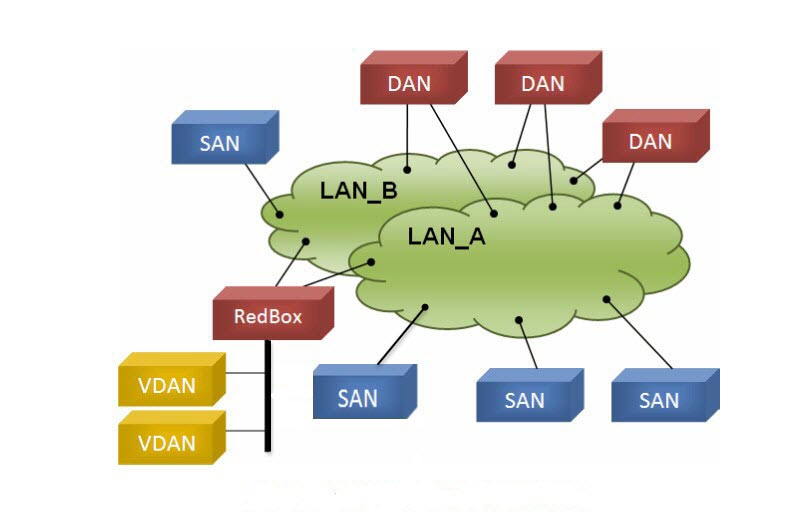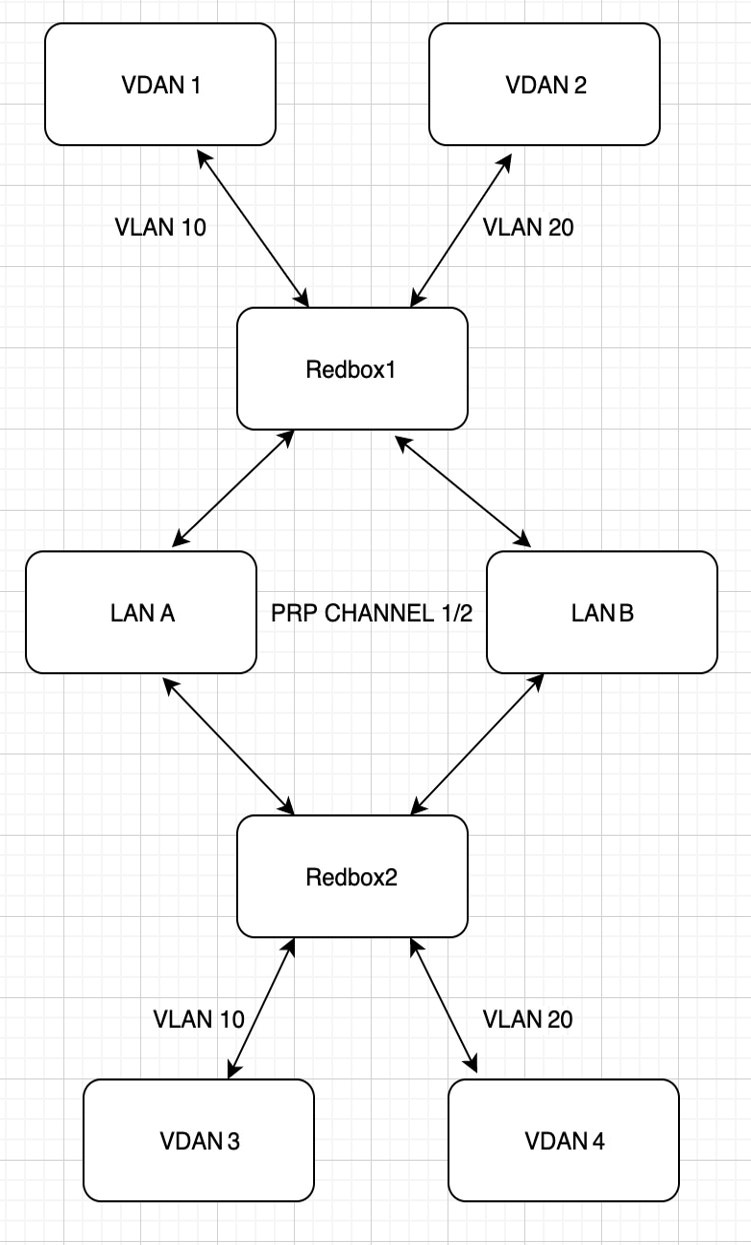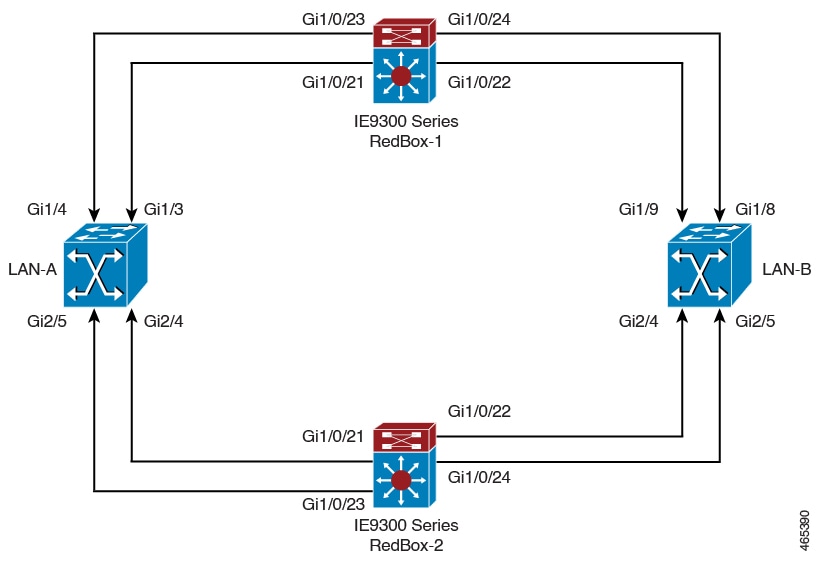Information about PRP
Parallel Redundancy Protocol (PRP) is defined in the International Standard IEC 62439-3. PRP provides redundancy in Ethernet networks, enabling recovery to occur instantly after failures.
PRP is supported on several Cisco Catalyst IE9300 Rugged Series Switches .
-
IE-9320-26S2C-E and IE-9320-26S2C-A beginning with Cisco IOS XE Cupertino Release 17.7.1.
-
IE-9320-22S2C4X-E and IE-9320-22S2C4X-A beginning with Cisco IOS XE Dublin Release 17.12.1.
-
IE-9310-16P8S4X-E and IE-9310-16P8S4X-A beginning with Cisco IOS XE 17.18.1 onwards.
Traditional redundancy vs. PRP
To recover from network failures, redundancy can be provided by network elements connected in mesh or ring topologies using protocols like RSTP, REP, or MRP, where a network failure causes some reconfiguration in the network to allow traffic to flow again (typically by opening a blocked port). Network recovery and resumption of traffic with these redundancy schemes can take from a few milliseconds to several seconds.
PRP uses a different scheme. The end nodes implement redundancy by connecting two network interfaces to two independent, parallel networks, LAN-A and LAN-B. Each of these Dually Attached Nodes (DANs) then have redundant paths to all other DANs in the network.
How PRP works with dually attached nodes (DANs)
The DAN sends two packets simultaneously through its two network interfaces to the destination node. Each frame includes a redundancy control trailer (RCT) with a sequence number. This addition helps the destination node distinguish between duplicate packets. When the destination DAN receives the first packet successfully, it removes the RCT and consumes the packet. If the second packet arrives successfully, it is discarded. If a failure occurs in one of the paths, traffic continues to flow over the other path uninterrupted, and recovery occurs instantly.
Singly attached nodes (SANs)
Non-redundant endpoints in the network that attach only to either LAN-A or LAN-B are known as Singly Attached Nodes (SANs).
Redundancy box (RedBox) and virtual DAN (VDAN)
A Redundancy Box (RedBox) is used when an end node that does not have two network ports and does not implement PRP needs to implement redundancy. Such an end node can connect to a RedBox, which provides connectivity to the two different networks on behalf of the device. Because a node behind a RedBox appears for other nodes like a DAN, it is called a Virtual DAN (VDAN). The RedBox itself is a DAN and acts as a proxy for the VDANs it represents.
The image here shows a PRP redundant network.

Supervision frames
Supervision frames are special types of frames used for monitoring and maintaining the integrity of redundant networks. To manage redundancy and check the presence of other DANs, a DAN periodically sends Supervision frames and can evaluate the Supervision frames sent by other DANs.
Role of switches
IE-9320-26S2C-A, IE-9320-26S2C-E, IE-9320-22S2C4X-A, IE-9320-22S2C4X-E, IE-9310-16P8S4X-E, and IE-9310-16P8S4X-A switches implement RedBox functionality using Gigabit Ethernet port connections to each of the two LANs.
PRP Channels
A PRP channel, also called a channel group, aggregates two Gigabit Ethernet interfaces—either access, trunk, or routed—into a single logical link. In a channel group, the Gigabit Ethernet member port with the lower number is the primary port and connects to LAN-A. The port with the higher number functions is the secondary port and connects to LAN-B.
At least one member port must remain up and send traffic for the PRP channel to operate. If both member ports are down, the channel is also down. Each switch supports a maximum of two PRP channel groups.
The interfaces available for each group on each switch series are fixed. The tables in this section show the specific interfaces.
|
Switch Model |
PRP Channel Number |
LAN-A Interfaces |
LAN-B Interfaces |
|---|---|---|---|
|
IE-9320-26S2C-A, IE-9320-26S2C-E, IE-9320-22S2C4X-A, IE-9320-22S2C4X-E |
Channel 1 |
Gi1/0/21 |
Gi1/0/22 |
|
Channel 2 |
Gi1/0/23 |
Gi1/0/24 |
|
|
IE-9310-16P8S4X-E, IE-9310-16P8S4X-A |
Channel 1 |
Gi1/0/1 or Gi1/0/9 |
Gi1/0/2 or Gi1/0/10 |
|
Channel 2 |
Gi1/0/3 or Gi1/0/11 |
Gi1/0/4 or Gi1/0/12 |
Mixed traffic and supervision frames
Traffic egressing the RedBox PRP channel group can be mixed, meaning that it is destined to either SANs (connected only on either LAN-A or LAN-B) or DANs. To prevent duplication of packets for SANs, the switch learns source MAC addresses in two ways: from received supervision frames for DAN entries, and from non-PRP (regular traffic) frames for SAN entries, maintaining these addresses in the node table. When forwarding packets out the PRP channel to SAN MAC addresses, the switch looks up the entry to determine the appropriate LAN and prevents packet duplication.
A RedBox with VDANs must send supervision frames on behalf of those VDANs. When traffic arrives on all other ports and exits through PRP channel ports, the switch learns source MAC addresses, adds them to the VDAN table, and begins sending supervision frames for these addresses. Learned VDAN entries are subject to aging.
VLAN tags in supervision frame
Cisco Catalyst IE9300 Rugged Series Switches support VLAN tagging for supervision frames. PRP VLAN tagging requires that PRP interfaces be configured in trunk mode. This feature allows you to specify a VLAN ID in the supervision frames for a PRP channel.
Example: Configuring PRP channel with supervision frame VLAN tagging
In the example configuration diagram below, PRP channel 1 interface is configured in trunk mode with allowed VLANs 10 and 20. Supervision frames are tagged with VLAN ID 10. RedBox1 sends Supervision frames on behalf of VDANs with the PRP VLAN ID, but the regular traffic from VDANs goes over the PRP channel based on the PRP trunk VLAN configuration.

See Configure PRP channel with supervision frame VLAN tagging for configuration information.


 Feedback
Feedback